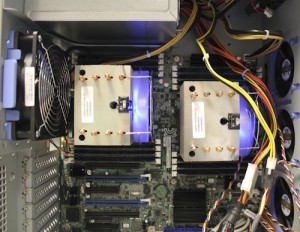TEST SETUP AND METHODOLOGY
 In testing the Micron M500DC, along with all enterprise drives, we focus on long term stability. In doing so, we stress products not only to their maximum rates, but also with workloads suited to enterprise environments.
In testing the Micron M500DC, along with all enterprise drives, we focus on long term stability. In doing so, we stress products not only to their maximum rates, but also with workloads suited to enterprise environments.
We use many off-the-shelf tests to determine performance, but we also have specialized tests to explore specific behaviors we encounter. With enterprise drives, you will see that we do not focus on many consumer level use-cases.
Our hope is that we present tangible results that provide relevant information to the buying public.
LATENCY
To specifically measure latency, we use a series of 512b, 4K, and 8K measurements. At each block size, latency is measured for 100% read, 65% read/35% write, and 100% write/0% read mixes.

The M500DC performed well in our average latency testing. Specifically, 0% read operations at 4KB, where it really shined. Converting latency to IOPS yields an impressive 42K IOPS.

Maximum latency calculations help show us if an SSD has bad behaviors that cannot be observed when the data is averaged. The M500DC had no such behaviors. For all of our runs, the maximum latency observed was less than 30ms. So far, Micron seems to be exceeding the specified performance, but our next round of tests should give us even more insight.
ADVANCED WRITE TESTING
As we talked about in our Micron P400m SSD Review, SSDs have different performance states. Since the Micron M500DC is an enterprise SSD, we will focus on steady state performance. With the following tests, we stressed the drive using random 4KB write workloads across the entire span for at least 24 hours. This is more than enough to achieve steady state. The following graph is showing the latency and IOPS across an 11 hour span.

Each point is a 1 minute average, which should give us a good idea how the drive is performing. The M500DC absolutely killed our advanced write tests. Looking at 1 minute averages, the M500DC was steady as a rock at over 37.5K IOPS, well above the 35K IOPS Micron promises. That is also enough to clear the SanDisk Optimus Eco, which achieved 35K IOPS.


When we took a look at the last hour of the test, showing 1 second averages, the results were just as impressive. Even though the grouping of IOPS was larger than the SanDisk Optimus Eco, the M500DC still had an excellent showing. There is a portion of averages that dipped 33K IOPS, though the vast majority were above 35K, peaking at 42K IOPS. This is definitely not the sort of results you expect from a drive that is trying to keep costs low.
 The SSD Review The Worlds Dedicated SSD Education and Review Resource |
The SSD Review The Worlds Dedicated SSD Education and Review Resource | 
I can’t find any warranty information on this product except from this review. Does it really have a 5 year warranty? And where would you go to get a failing drive replaced under this warranty? Crucial doesn’t list it at all for warranty coverage.
Yes and that would be dealt with through Micron directly as it is as enterprise SSD. Simply contact them.
I have about 60 of these drives in two SANs. Phenomenal performance, I really love them. However I had one fail last week and the warranty process is a nightmare. They do NOT handle RMAs and warranties, they want you to go through the original reseller for the limited warranty. Newegg, Ingram Micro, CDW, etc. are NOT considered “authorized distributors” which means that Micron will NOT accept RMAs if purchased from them. If I had known this prior to purchasing I would not have gotten the Micron. Here is their list of “authorized” distributors. I am really unhappy right now. https://www.micron.com/support/how-to-buy/authorized-distributors
I am checking on this.
Let me know if you want me to forward you the email chain.
Any luck with Micron?
No response sorry.
Would the performance numbers and consistency of the 240GB be close to those of the tested 480GB drive?
edit:
I found this, what is a detailed meassurement of the 240GB Drives, and looks good.
https://www.thomas-krenn.com/de/tkmag/wp-content/uploads/2014/03/Micron-M500DC-240GB.pdf